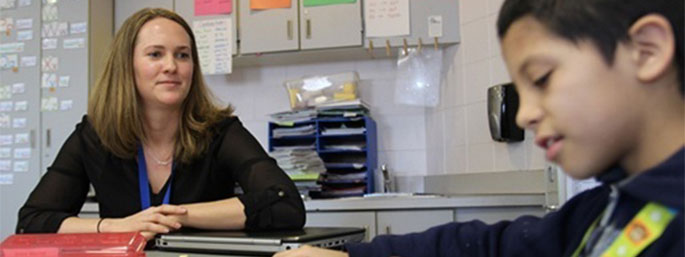Let’s say you’re a teacher who has been in the classroom for six years, getting strong results with your students in a high-need school. You’re consistently evaluated as effective, and you feel that you’ve really hit your stride in the classroom. But you’re hungry for a different challenge, one that takes you outside the four walls of your classroom. Unfortunately, your choices come down to staying in your current job for the next 20 years, or leaving the classroom to move into administration—or another career altogether. It’s all or nothing.
This either/or feels intractable to many teachers, but it’s a dilemma that districts can solve. In Denver Public Schools (DPS), the district has used its federal Teacher Incentive Fund (TIF) grant as a springboard to create new teacher leadership roles, where lead teachers divide their time between classroom instruction and coaching, planning with and supporting a small team of teachers in their school. Through these roles, expert teachers can stretch their skills and create new connections across classrooms without leaving teaching entirely—in short, they can share leadership and fundamentally change what it means in their schools.
The “Differentiated Roles” pilot will expand from 14 to more than 40 schools next year, and is expected to grow to more than half the district’s schools by its third year. DPS Superintendent Tom Boasberg has made it clear that this isn’t a short-term priority that will dissipate after the TIF grant runs out. The district is already using its own dollars to co-fund the work and will continue to do so into the future.
In Superintendent Boasberg’s words: “Expanding teacher leadership in our schools is critical to strengthening teacher teams, improving peer-to-peer learning opportunities and attracting and retaining talented teachers in our schools. I am very excited by the promise of this opportunity.”
By sharing leadership, Differentiated Roles addresses separate challenges faced by teachers and school leaders. It provides career growth opportunities for teachers who want to keep teaching, while providing important help to school leaders by drawing on talent already on-hand to support teacher effectiveness throughout a school. Principals don’t have enough time in the day to observe every teacher and give them the kind of feedback and support they need to improve, so teacher leaders in the Differentiated Roles program fill that capacity gap. Teacher leaders grow in their careers by taking on the responsibility of growing other teachers.
Teachers are seeing the effects of the shared leadership pilot already, as it provides real-time feedback that results in more effective teaching practices across schools. Here’s how Alicia FaJohn, a fifth grade team lead at Westerly Creek, explains it: “As a teacher team lead, I can take those pockets of excellence that you see happen in classrooms—which have been isolated for so many years—and now it’s a fire, a wildfire. Now it’s hallways of excellence. You can hear it in every classroom.”
Such programs are not automatically successful; we’ve seen some uninspired, modest attempts at establishing so-called “lead teachers” that amount to a full teaching load, plus a side of extra work, for a little extra cash. There are several elements to the Differentiated Roles pilot that we see as truly transforming teachers’ potential career paths, and which we believe are important ingredients for any successful teacher leadership career pathway:
Teacher leaders’ additional responsibilities are not treated as add-ons or supplements to their normal teaching loads. Each teacher leader is released from the classroom between 25-50 percent of the time in order to fulfill their leadership responsibilities, which include contributing to teacher evaluations. This means that DPS is meaningfully investing in the work of the teacher leaders by supporting the costs associated with additional teaching staff.
Teacher leaders are fairly compensated for their additional responsibilities. In addition to release time, teacher leaders receive additional training in leading other adults and a several-thousand dollar stipend to reward the additional work they are expected to be doing with their teacher teams.
Teacher leaders have clear job descriptions and are held accountable for meeting teaching and learning objectives. Since each school must re-apply for the pilot each year and principals choose whether to retain teacher leaders in their roles from one year to the next, expectations for what success looks like for both the school leader and the teacher leader are made quite clear.
Developing teacher leadership pathways is an innovation that is growing in popularity, which is good to see. Our research has shown that career growth is a major reason high-performing teachers opt to leave their schoolsoverall enthusiasm for the pilot, which promotes the sort of strong instructional culture of feedback and support that our research has found boosts student achievement, is of note. We’ll be watching closely.








